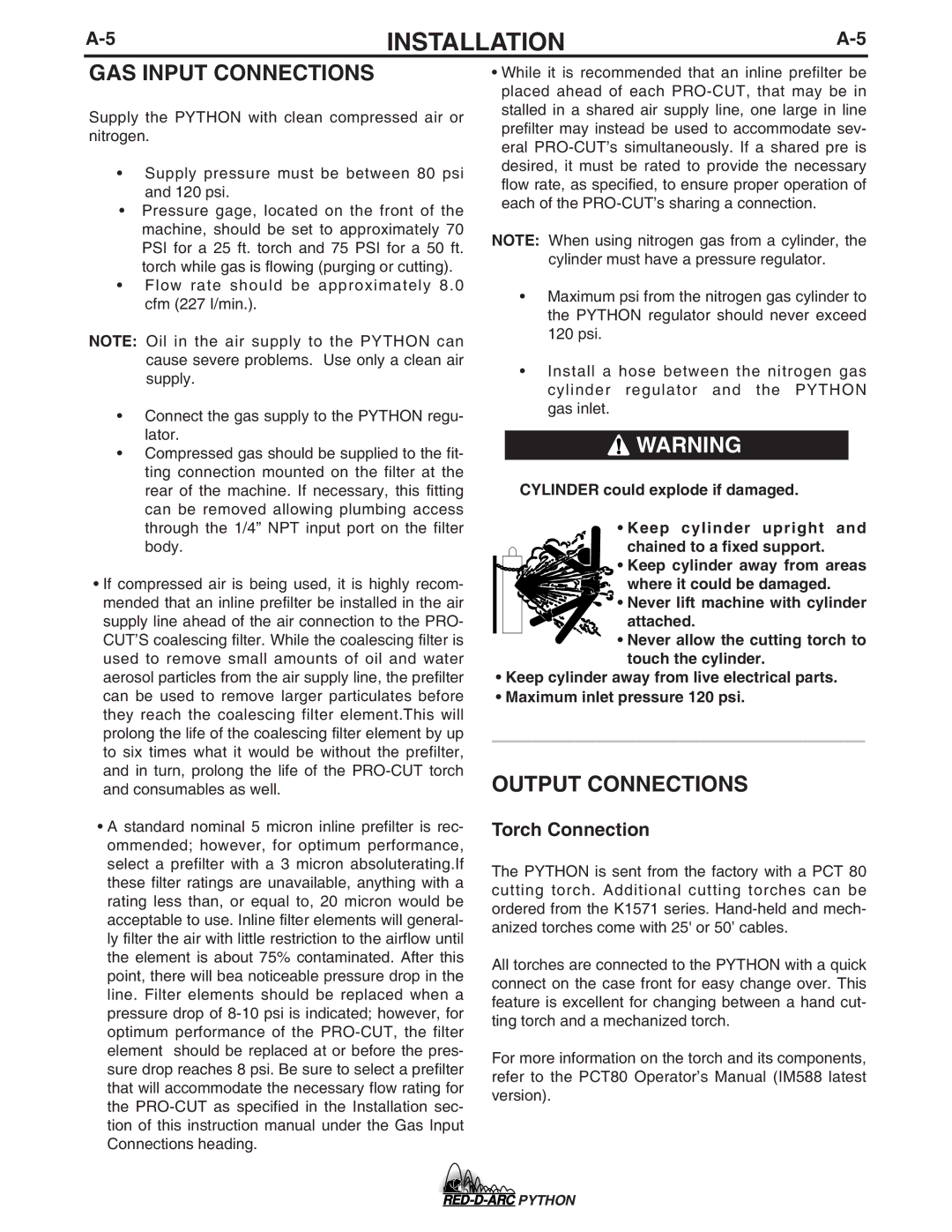
INSTALLATION | ||
|
|
|
GAS INPUT CONNECTIONS
Supply the PYTHON with clean compressed air or nitrogen.
•Supply pressure must be between 80 psi and 120 psi.
•Pressure gage, located on the front of the machine, should be set to approximately 70 PSI for a 25 ft. torch and 75 PSI for a 50 ft. torch while gas is flowing (purging or cutting).
•Flow rate should be approximately 8.0 cfm (227 I/min.).
NOTE: Oil in the air supply to the PYTHON can cause severe problems. Use only a clean air supply.
•Connect the gas supply to the PYTHON regu- lator.
•Compressed gas should be supplied to the fit- ting connection mounted on the filter at the rear of the machine. If necessary, this fitting can be removed allowing plumbing access through the 1/4” NPT input port on the filter body.
•If compressed air is being used, it is highly recom- mended that an inline prefilter be installed in the air supply line ahead of the air connection to the PRO- CUT’S coalescing filter. While the coalescing filter is used to remove small amounts of oil and water aerosol particles from the air supply line, the prefilter can be used to remove larger particulates before they reach the coalescing filter element.This will prolong the life of the coalescing filter element by up to six times what it would be without the prefilter, and in turn, prolong the life of the
•A standard nominal 5 micron inline prefilter is rec- ommended; however, for optimum performance, select a prefilter with a 3 micron absoluterating.If these filter ratings are unavailable, anything with a rating less than, or equal to, 20 micron would be acceptable to use. Inline filter elements will general- ly filter the air with little restriction to the airflow until the element is about 75% contaminated. After this point, there will bea noticeable pressure drop in the line. Filter elements should be replaced when a pressure drop of
•While it is recommended that an inline prefilter be placed ahead of each
NOTE: When using nitrogen gas from a cylinder, the cylinder must have a pressure regulator.
•Maximum psi from the nitrogen gas cylinder to the PYTHON regulator should never exceed 120 psi.
•Install a hose between the nitrogen gas cylinder regulator and the PYTHON gas inlet.
![]() WARNING
WARNING
CYLINDER could explode if damaged.
• Keep cylinder upright and
chained to a fixed support.
• Keep cylinder away from areas
where it could be damaged.
![]()
![]() • Never lift machine with cylinder attached.
• Never lift machine with cylinder attached.
•Never allow the cutting torch to touch the cylinder.
•Keep cylinder away from live electrical parts.
•Maximum inlet pressure 120 psi.
__________________
OUTPUT CONNECTIONS
Torch Connection
The PYTHON is sent from the factory with a PCT 80 cutting torch. Additional cutting torches can be ordered from the K1571 series.
All torches are connected to the PYTHON with a quick connect on the case front for easy change over. This feature is excellent for changing between a hand cut- ting torch and a mechanized torch.
For more information on the torch and its components, refer to the PCT80 Operator’s Manual (IM588 latest version).
![]()
![]()
![]()
![]()
![]() PYTHON
PYTHON
